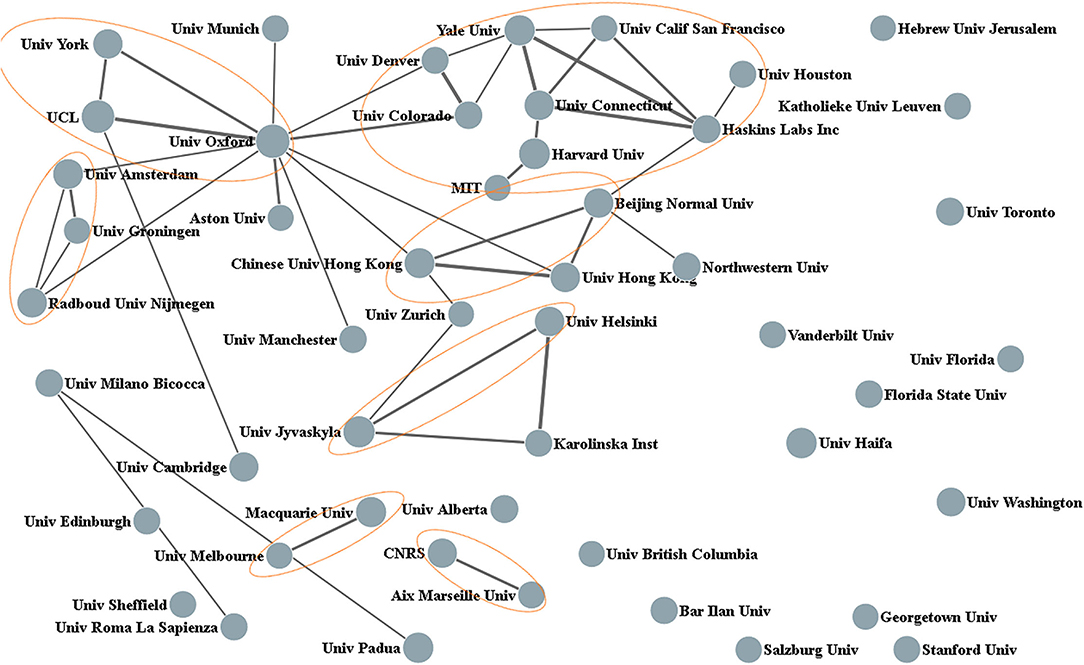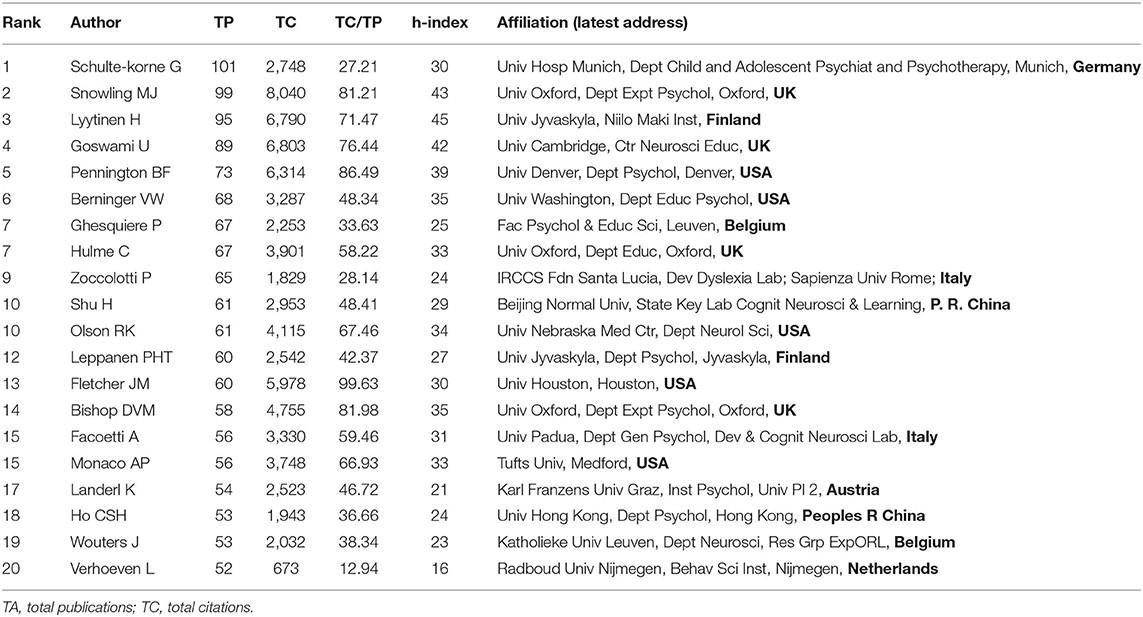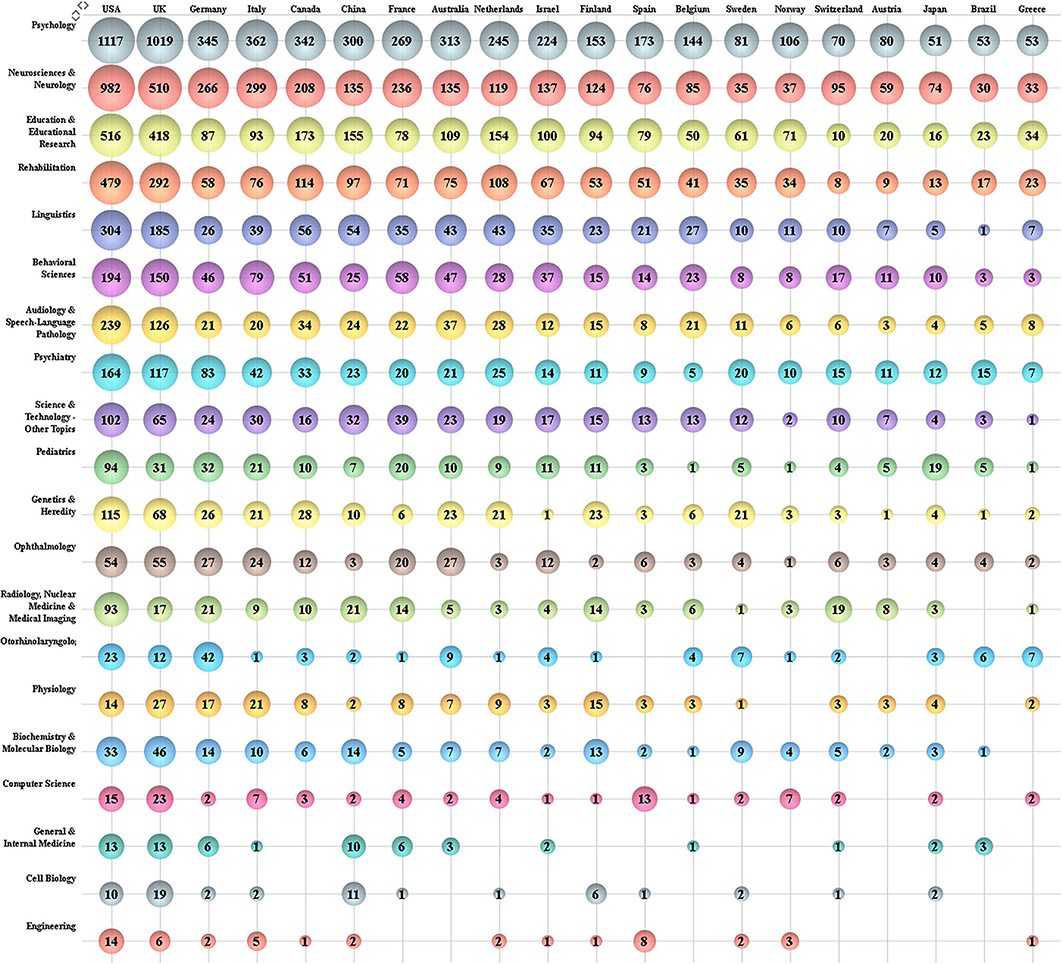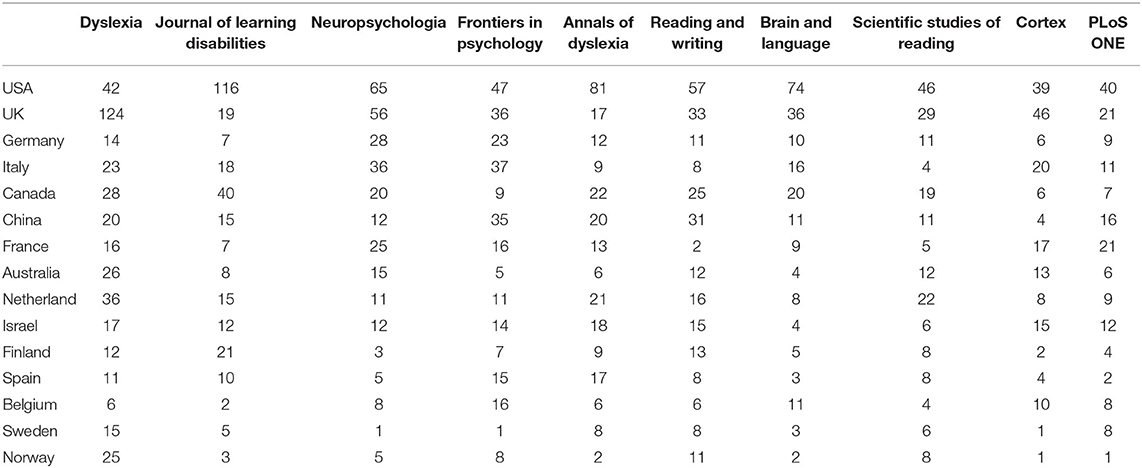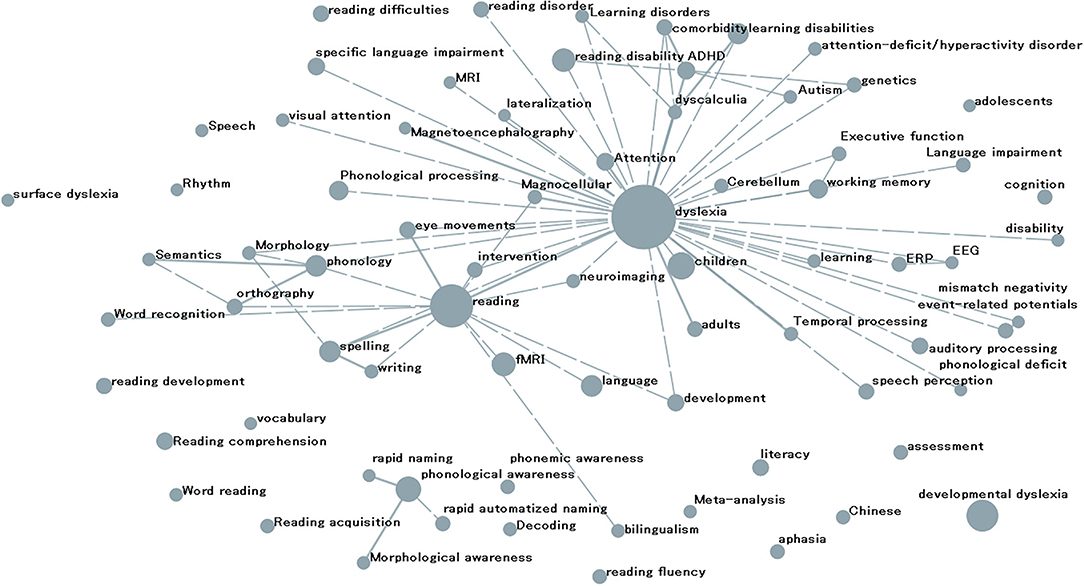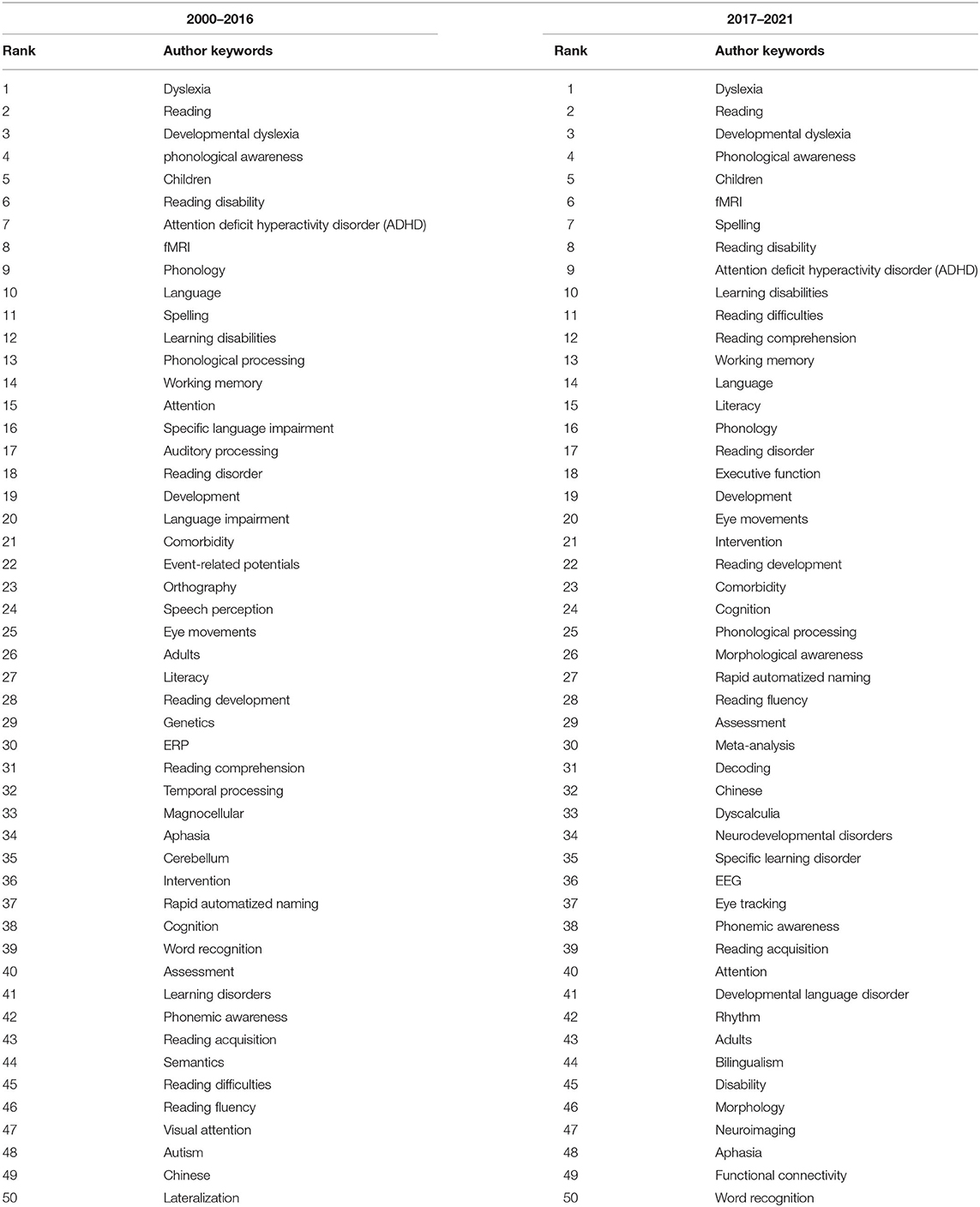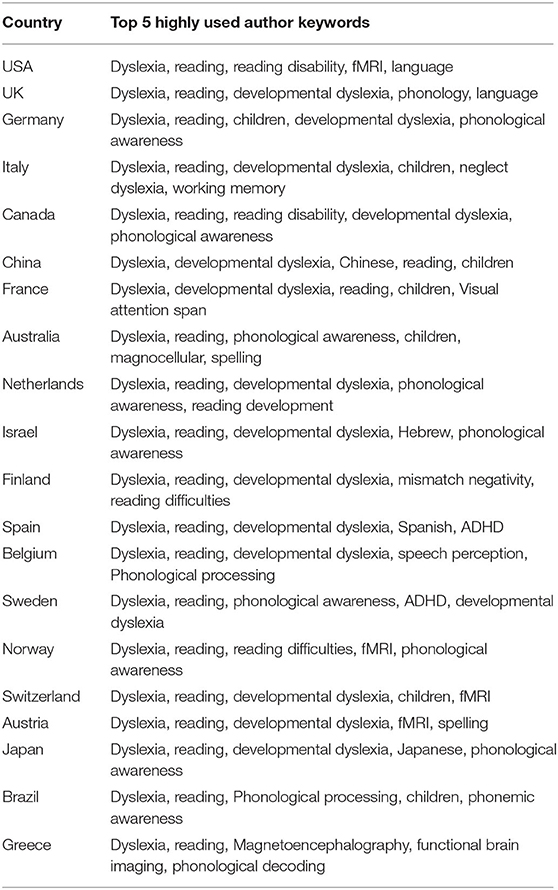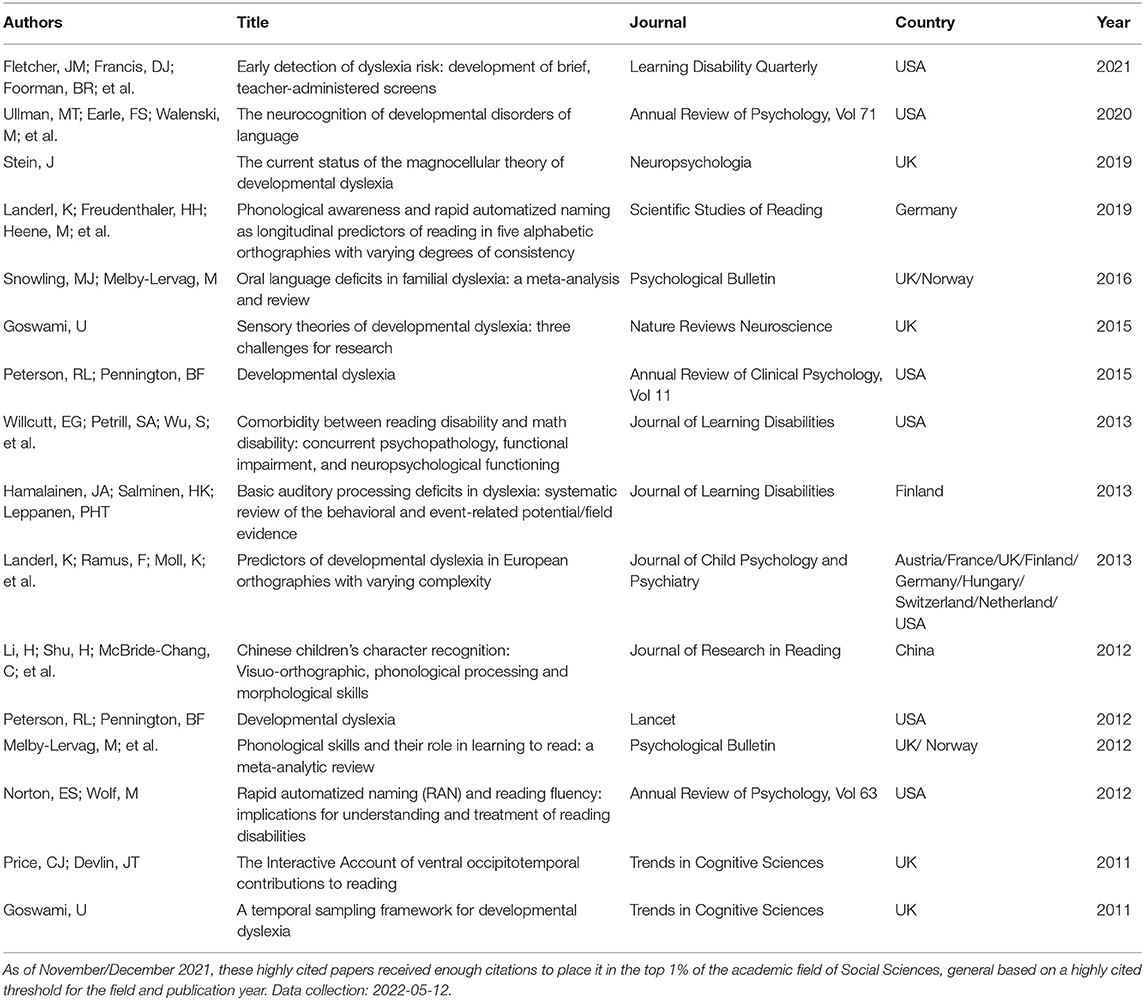- 1Institute of Information Resource, Zhejiang University of Technology, Hangzhou, China
- 2Library, Zhejiang University of Technology, Hangzhou, China
Dyslexia is a disorder characterized by an impaired ability to understand written and printed words or phrases. Epidemiological longitudinal data show that dyslexia is highly prevalent, affecting 10–20% of the population regardless of gender. This study aims to provide a detailed overview of research status and development characteristics of dyslexia from types of articles, years, countries, institutions, journals, authors, author keywords, and highly cited papers. A total of 9,166 publications have been retrieved from the Social Sciences Citation Index (SSCI) and Science Citation Index Expanded (SCI-E) from 2000 to 2021. The United States of America, United Kingdom, and Germany were the top three most productive countries in terms of the number of publications. China, Israel, and Japan led the Asia research on dyslexia. University of Oxford had the most publications and won first place in terms of h-index. Dyslexia was the most productive journal in this field and Psychology was the most used subject category. Keywords analysis indicated that “developmental dyslexia,” “phonological awareness,” children and fMRI were still the main research topics. “Literacy,” “rapid automatized naming (RAN),” “assessment,” “intervention,” “meta-analysis,” “Chinese,” “executive function,” “morphological awareness,” “decoding,” “dyscalculia,” “EEG,” “Eye tracking,” “rhythm,” “bilingualism,” and “functional connectivity” might become the new research hotspots.
Introduction
The term dyslexia is derived from the Greek script and was first proposed in 1887 by Dr. Rudolf Berlin in his work “Eine besondere Art der Wortblindheit (Dyslexie)”. In 1994, Lyon proposed a working definition of dyslexia, and later in 2002, a revised version of dyslexia was approved as “dyslexia is a specific learning that is neurobiological in origin that is characterized by difficulties with accurate and/or fluent word recognition and by poor spelling and decoding abilities” (1, 2). In 1896, Hinshelwood J. published a case of dyslexia (3). There were almost no publications on dyslexia from 1900 to 1945 and the possible reason might be the turmoil of society and the world wars. Since 1946, more scientific research gradually uncovers the reasons behind dyslexia including the causes, symptoms, clinical diagnosis, and improvement measures (4–13). Although the root cause of dyslexia is still unclear, researchers do have some explanations that give us a better understanding of dyslexia and people with dyslexia (14–21). According to the European dyslexia association (EDA), the incidence of dyslexia worldwide is about 9–12%. At present, some countries have passed a series of legislation to promote better identification of people with dyslexia, and to protect the rights in education, employment, and access to public services of individuals with dyslexia (22–25).
Bibliometrics was proposed by Alan Pritchard in 1969, defined as “the application of mathematics and statistical methods to books and other media of communication” (26). Bibliometrics is an important branch of information science and philology. At the same time, it also shows important methodological value and becomes a special research method of information science. The number of bibliometrics academic papers published each year around the world is continually increasing, with about 3,000 in 2021. Bibliometric analyses are useful tools to quantitatively analyze academic literature to get a good understanding of the research trends in specific areas of science and technology, such as public health care (27–32), drug discovery (33–35), nursing (36, 37), biomass (38–42), and COVID-19 (43–49). Bibliometrics has become an academic link closely related to science communication and basic theories. To our knowledge, few comprehensive bibliometric studies have been performed on the dyslexia research literature. Ram (50) conducted an analysis of dyslexia literature (1967–2016) from Scopus, which mainly studied the document types, trends of the number of publications, most productive countries, journals, authors, and keywords. Recently, Zhang et al. (51) published a paper on the top 100 most-cited studies of dyslexia research. Due to the language and the stages of cognition of dyslexia, there is still a need to carry out a comprehensive analysis on the differences of bibliometric characters and research priorities and hotspots of dyslexia research from a country perspective.
To fill this research gap, this study (1) uses the bibliometric method to indicate the status and development trends using major research areas, productive institutes, and journals from a country perspective, (2) analyzes the collaboration patterns between countries and organizations, (3) explores the priorities and hotspots by analyzing the author keywords from temporal evolution and a country perspective. This study demonstrates the status of studies of dyslexia from a country perspective, which offers readers a fresh perspective and suggestions to dyslexia students and families, researchers, and policymakers for future challenges and policy formulation.
Methods
The analysis was based on the publications related to “dyslexia” which were retrieved through the Social science citation index (SSCI) and science citation index expand (SCI-E) during the period 2000 to 2021. The data were obtained from the Web of Science (WoS) Core Collection by searching the title, abstract, author keywords, and KeyWords plus with search formula of “dyslexia” on January 14th, 2022. The graphical analysis of cooperation uses bibliographic coupling, co-citation, citation, co-authorship, and co-occurrence metrics. We used the Derwent Data Analyzer (DDA) software to present the outcomes of bibliometric analyses. Articles originating from England, Scotland, Wales, and Northern Ireland were grouped under the United Kingdom (UK) heading. The impact factor (IF) for each journal was determined according to the report from the 2020 Journal Citation Reports (JCR). Note that some related publications that did not use “dyslexia” in their topic parts may not be included in this analysis. This issue might produce some deviations.
Results
General Statistics
In total, 9,166 papers were obtained from the WoS, including 14 article types. They were articles (7,651), review articles (589), meeting abstracts (409), editorial materials (262), proceedings papers (248), early access (127), letters (101), book reviews (97), corrections (31), book chapters (24), news items (21), biographical-items (4), retracted publications (2), and reprints (1). The vast majority of publications were published in English (8,776; 95.745%), followed by German (197; 2.419%), French (79; 0.862%), Spanish (62; 1.480%), Portuguese (12; 0.131%), Czech (10; 0.109%), and others (30; 0.330%). The following analysis was based on the top eight document types which are the majority of the publications in this field.
Total 99 countries have published articles on the topic of dyslexia from 2000 to 2021. Figure 1 show the annual analysis of published papers of the top 10 most productive countries. The United States of America published the most articles (2,589) and the highest h-index (148). United Kingdom was in the second position with a total of 1,811 publications. Other productive countries included Germany (721), Italy (648), Canada (598), China (564), France (558), Australia (506), the Netherlands (445), and Israel (380). From 2000 to 2007, the annual output of publications in China did not exceed 10. Thereafter, the number of publications increased rapidly and reached 59 in 2020. In summary, no countries from Africa, and although publications from Asia countries (China and Israel) have increased quickly in the past 10 years, publications from the United States of America and European countries have dominated the dyslexia research field because of their longer accumulation of expertise.
International Cooperation Analysis
The academic collaboration networks of countries were extracted using Derwent Data Analyzer (DDA) software based on the co-occurrence matrix of author's country and country cooperation. The result of the top 20 most productive countries' cooperation (with a minimum of 5 shared publications) is shown in Figure 2. The size of nodes represents the number of publications. The lines between the nodes represent the cooperative frequency. The United States of America is the country with the highest number of papers in the dyslexia research field, followed by the United Kingdom, Germany, Italy, Canada, and China. As can be seen in Figure 2, the United States of America cooperated most frequently with the United Kingdom, Canada, and China. Furthermore, the United States of America and United Kingdom had the biggest collaboration network among the top 20 most productive countries. Researchers from Japan, Brazil, and Greece need to strengthen their international cooperation. China, Israel, and Japan led the research in Asian countries.
Organization Co-occurrence Analysis
A total of 4,869 organizations have published papers on the study of dyslexia. The top 15 most productive organizations concerning the number of publications and h-index have been enlisted in Table 1. The University of Oxford ranked first in terms of total publications and obtained the highest h-index (75), followed by UCL and the University of Jyvaskyla. Yale University has the highest number of ACCP. Figure 3 shows the cooperation between organizations with a minimum of 8 papers among the top 50 productive organizations. As shown in Figure 3, institutions from the same country were more closely connected. This was confirmed by the analysis of the top 3 most collaborative organizations for each institution (see Table 1). The University of Oxford has the largest collaborative network.
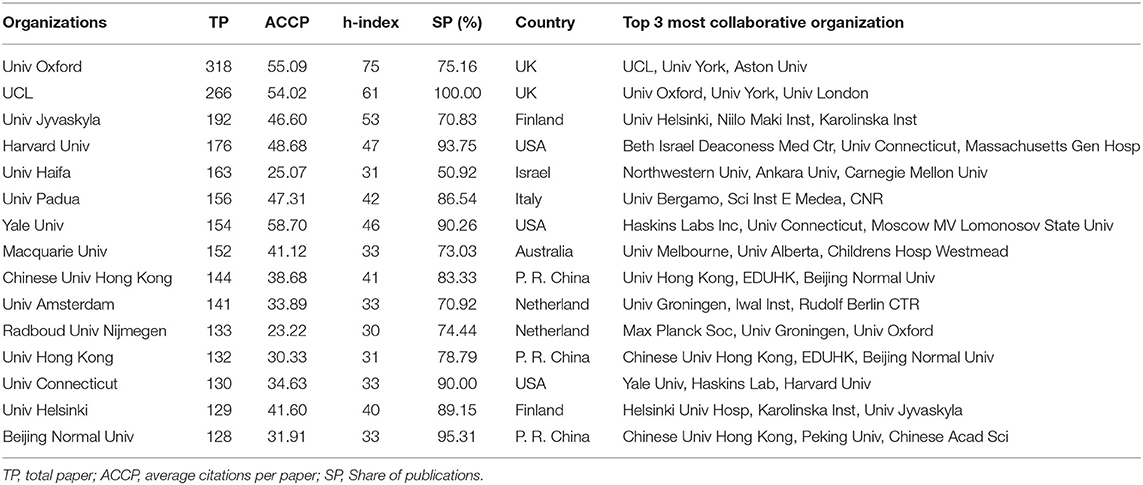
Table 1. The top 15 most productive organizations of publication, citations and h-indices during 2000–2021.
In addition, we analyzed the share of cooperative publications between institutes (see Table 1). It can be seen that all the 15 most productive institutions except University Haifa have very high collaboration rates, especially the UCL, Harvard University, Yale University, and the University of Connecticut. Interestingly, all of the top 15 prolific organizations are universities. It suggests that dyslexia research is mostly held by universities.
Prolific Authors' Analysis From a Country Perspective
There are 17,009 authors who have published at least one paper on the research of dyslexia. Table 2 outlines the top 20 contributing authors based on the number of publications they authored or co-authored. As can be seen in these data, all of the authors are from the top 20 productive countries. Among the top 20 prolific authors, five authors are from the united States of America, four from United Kingdom, two from Finland, P. R. China, Belgium, and Italy, and one from Germany, the Netherlands, and Austria. Schulte-korne G. ranked first on the list with the highest number (101) of dyslexia papers, Snowling MJ obtained the second one with 99 papers, and Lyytinen H obtained the third one with 95. For the average citation per paper, Fletcher JM ranked first with 99.63, followed by Pennington BF (86.49) and Bishop DVM (81.98). Looking to the H-index record, Lyytinen H obtained the first position with 45, followed by Snowling MJ, Goswami U, and Pennington BF. It is worth noting that three out of four United Kingdom researchers are from the same institution, the University of Oxford. Once again it proved the outstanding contribution of the University of Oxford to dyslexia research.
Schulte-korne G. is from Ludwig-Maximilians-University of Munich and his main research areas in dyslexia include genetics (52–56), assessment (57, 58), intervention (59–62), language (63, 64), and cognitive neuroscience (55, 65, 66). Snowling MJ, listed in the second place, is from the University of Oxford and her research on dyslexia focuses on language impairment (67–69), comorbidity (70, 71), and intervention (72–76). Lyytinen H is from the University of Jyvaskyla and his research on dyslexia focuses on the longitudinal study (21, 77–79), speech perception (80–82), auditory processing (83–85), and intervention (86, 87).
Research Area and Journal Analysis From a Country Perspective
Research works on dyslexia have been carried out in about 101 research areas in SCI and SSCI databases. Figure 4 shows the number of papers published by the top 20 most productive countries in the top 20 most productive research areas. “Psychology” ranked first in terms of the total publications of all countries. “Neurosciences Neurology” and “Education Educational Research” are listed in the second or third position in all countries. Sweden, Spin, Norway, the Netherlands, China, and Greece had published more papers on “Education Educational Research” than “Neurosciences Neurology”.
The 9,110 papers related to dyslexia research during 2000–2021 were published in 1,156 journals. Table 3 shows the number of papers published by the top 15 most productive countries in the top 10 most productive journals. About 30% of articles were published in these top 10 productive journals in the top 15 countries. Dyslexia published the most articles in this research field (415 publications), followed by Neuropsychologia (302), Journal of Learning Disabilities (296), and Frontiers in Psychology (280). United Kingdom published the most articles in Dyslexia while United States of America published more articles in the Journal of Learning Disabilities and Annals of Dyslexia than other countries. These suggested that the United Kingdom and United States of America researchers prefer to publish in journals hosted by their countries.
An Analysis of Author Keywords From a Global Perspective
Keywords analysis has been used widely to analyze research hotspots and trends (88–93). To identify the research focus of dyslexia research, 9,562 author keywords which appeared 32,757 times from 9,110 papers were analyzed. Keywords with the same meanings were grouped and represented by one unified word or phrase, and the publications that lack author keywords may not be included in this analysis. Among the author keywords, 6,705 (70%) were used only once. The high percentage of once-only author keywords may indicate a lack of continuity in research and a wide range of interests in dyslexia research.
Figure 5 shows a network map of author keywords co-occurrence analysis (frequency not <50 times) related to dyslexia. As seen in the analysis result in Figure 5, the keywords “dyslexia” and “reading” occupied the core positions. The top high-frequency nodes linked with “dyslexia” are “reading,” “children,” “attention,” “dyscalculia,” “magnocellular,” “adults,” “magnetoencephalography,” and “MRI”. Keywords “fMRI,” “eye movements,” “spelling,” “intervention,” “phonology,” and “writing” were the top high-frequency nodes connected to “reading”.
To better understand the development trend of research, we compared the top 50 high-frequency author keywords in the past 5 years and the first 16 years (see Table 4); “dyslexia” and “developmental dyslexia” were exceptions because these keywords were among the search terms of the data that were used in this study. “Phonological awareness,” “reading,” and “spelling” are the main research aspects; “children” are the main group studied. “fMRI” was still a strong and useful technique to measure the brain activity of dyslexia and remained among the top eight most frequently used keywords (94, 95). “Literacy” refers to the quality or state of being literate, especially the ability to read and write. The rank of “literacy” increased from 27th in 2000–2016 to 15th in 2017–2021, suggesting that the research of literacy remained hot research during the past 20 years.
With the in-depth research and experience accumulation of dyslexia, early intervention and prevention of dyslexia have important social significance (96). “Rapid automatized naming (RAN)” as one of the effective cognitive measures drew the attention of researchers that involved in creating optimal assessments and interventions (97). In fact, the rank of “Rapid automatized naming” had an apparent upward movement from 37th in 2000–2016 to 27th in 2017–2021. Both “Assessment” and “intervention” also had a big upward movement from 40th in 2000–2016 to 29th in 2017–2021 and 36th in 2000–2016 to 21st in 2017–2021, respectively. In 1976, Gene Glass first used the name “Meta-analysis” to represent the process and method of integrating and analyzing many empirical studies on the same subject through statistical analysis to obtain the most representative conclusions. This method had become an important tool for analyzing various research results of dyslexia (98–101) and “meta-analysis” reached the 30th in 2017–2021 from 95th in 2000–2016.
In the 1980s and 1990s, Chinese scholars began to study dyslexia in reading Chinese, but most of the results were published in their Chinese journals. In recent years, with the enhancement of scientific research capabilities and international cooperation, increased research results have been published in international journals (102–106). The rank of “Chinese” had a dramatic increase from 49th in 2000–2016 to 32nd in 2017–2021. It is also worth mentioning that “executive function” (107, 108), “morphological awareness” (109, 110), “Meta-analysis,” “decoding” (16), “dyscalculia,” “EEG” (111, 112), “Eye tracking” (113, 114), “rhythm” (115, 116), “bilingualism” (117, 118), and “functional connectivity” (119, 120) entered the top 50 high-frequency keywords in 2017–2021, suggesting that these topics may become the new research hotspots.
An Analysis of Author Keywords From a Country Perspective
Table 5 shows the 20 countries with the highest scientific production in dyslexia research as well as the keywords most used by these countries. Not surprisingly, “dyslexia,” “reading,” and “developmental dyslexia” were the keywords most used by most of these countries, ranking first to third in 15 of the 20 countries. “fMRI” was one of the research hotspots in the United States of America, Norway, Switzerland, and Austria. The language of early research on dyslexia was mainly English. In the 1970s, some researchers believed that the writing system of Asian countries would not cause dyslexia. However, with the development of early reading education activities by educators in some Asian countries, the problem of children's dyslexia had gradually attracted the attention of researchers. Therefore, it was not surprising that Asian countries (China, Japan, and Israel) had their language as one of their research focuses (104, 121–128).
An Analysis of Highly Cited Papers Based on WoS
The citation account is an important indicator of academic influence and was widely used in research evaluation. According to the Essential Science Indicators (ESI) database, highly cited papers (HCPs) refers to papers with citations in the top 1% of all papers based on a cited threshold for an academic field and publication year during the past 10 years. To some extent, HCPs from the ESI database might reflect research directions and hotspots in an academic field (129). Table 6 shows the HCPs of dyslexia over the last 10 years. One was published in the Lancet (IF = 79.323 in 2020) and Nature Reviews Neuroscience (IF = 34.87 in 2020). Two were published in the Annual Review of Psychology, Journal of Learning Disabilities, and Trends in Cognitive Sciences, respectively. Among the 16 HCPs, seven papers included authors from the United States of America and the United Kingdom, two from Germany, Finland, and Norway, and one from Finland, China, Austria, France, Hungary, Switzerland, and the Netherlands. It is worth mentioning that China was the only non-European and non-United States country, indicating that China has strengthened its development in this field of research. Among the 16 HCPs, two were about Rapid Automatized Naming (RAN) (97, 130) and two about meta-analysis (100, 101), indicating that RAN and meta-analysis became the hotspots in dyslexia research. “Predictors of developmental dyslexia” (131) and “Early detection of dyslexia risk” (96) might be one of the new dyslexia research directions.
Discussion
There is no doubt that more countries have taken dyslexia seriously over the past few decades. The United States of America, United Kingdom, and Germany had done well in publishing research papers in this field. Some Asian countries like China and Israel have started to play a role in dyslexia research. It is worth noting that in 2020–2021, the research results from China increased significantly, and the ranking jumped to third place based on the number of published papers in the past 2 years.
North America, Western and Northern Europe, Asia, and Australia were the most active regions in the research of dyslexia. This was further confirmed by most active institutions and authors. There were no organizations from Africa in the top 15 most productive institutions that indicated that the issues relating to dyslexia in low-income regions lag far behind in developed countries and regions. The possible reason might be poor awareness of dyslexia among educators, the public, funding input, economic level, etc. As dyslexia is a world health issue, we expect more Asian and African nations join this research area. Although, most of the dyslexia research is held by universities, it will benefit sharing its knowledge and experiences between organizations such as hospitals, schools, and research centers.
According to the keywords analysis, 65% of publications were about children, suggesting that the most of research was about children with dyslexia. At present, MRI technology is mostly used to explore the brain function and mechanism of dyslexia, among which fMRI research is at the forefront. As can be seen from Figure 5 and Tables 4, 6, “developmental dyslexia,” “phonological awareness,” children, and fMRI are still the hotspots in dyslexia research. By comparing the keywords in papers published before and after 2017, we found that the keywords “literacy,” “rapid automatized naming (RAN),” “assessment,” “intervention,” “meta-analysis,” “Chinese,” “executive function,” “morphological awareness,” “decoding,” “dyscalculia,” “EEG,” “Eye tracking,” “rhythm,” “bilingualism,” and “functional connectivity” were increasingly attracting the attention of researchers and had become some new research hotspots in dyslexia research. With the rapid development of the Internet, more knowledge is mainly obtained through network resources, and the effect of dyslexia on “information seeking” behavior has gradually attracted the attention of dyslexia researchers (132, 133). In addition, the emergence of a new keyword COVID-19 in the past 2 years also showed that during the COVID-19 epidemic, researchers began to study the impact of the epidemic on dyslexia research (115, 134–137). As the international exchange of dyslexia research continues to grow, scientists are aware that differences in education-related legislation in different countries may lead to persistent differences between psychologists' assessment practices. “Methods used by psychologists for identifying dyslexia: A systematic review” by Sadusky et al. (138) drew a conclusion that “a consensus operational definition of dyslexia and universal assessment guidelines” is needed. At the same time, the public library, as one of the important places for people to read, has thought about how to better serve dyslexic users (139, 140).
Conclusions
In this study, we presented a general overview of the dyslexia research area from a country perspective. The number of countries participating in dyslexia research increased to 68 in 2021 from 32 in 2000. In total, 99 countries published papers in this research field since 2000. All 9,110 publications were analyzed based on co-occurrence of country, institution, author, and author keyword. The United States of America, United Kingdom, and Germany were the top three most prolific countries and had the biggest collaboration network in the dyslexia research. Currently, international cooperation is still insufficient in Asian and African countries. The advanced expertise and experience of developed countries can be shared with developing countries through international cooperation. To our knowledge, there is no cure for dyslexia, but early assessment and intervention will give the best outcome. And also, people with dyslexia can learn to read with structured literacy which helps to rewire their brains. This was confirmed by the topmost used author keywords “intervention,” “assessment,” and “literacy”.
This study provided an insight into the status of current dyslexia research. It can also provide useful information for relevant researchers to find potential collaborators. In addition, this study may help to increase public awareness and acceptance of dyslexia, disseminate knowledge of dyslexia to educators, policymakers, and especially parents of children with dyslexia.
Data Availability Statement
The original contributions presented in the study are included in the article/supplementary material, further inquiries can be directed to the corresponding author/s.
Author Contributions
YWan and YC designed the study. WY is responsible for data collection. YC and XY analyzed the data. YWu analyzed, interpreted the data, and wrote the manuscript. All authors have read and agreed to the published version of the manuscript.
Funding
This research was funded by National Social Science Foundation of China (20BTQ028), the Scientific Research Program of Zhejiang Educational Committee (Y202147067), and Humanities and Social Sciences Research Foundation of Zhejiang University of Technology (SKY-ZX-20200076).
Conflict of Interest
The authors declare that the research was conducted in the absence of any commercial or financial relationships that could be construed as a potential conflict of interest.
Publisher's Note
All claims expressed in this article are solely those of the authors and do not necessarily represent those of their affiliated organizations, or those of the publisher, the editors and the reviewers. Any product that may be evaluated in this article, or claim that may be made by its manufacturer, is not guaranteed or endorsed by the publisher.
References
1. Lyon GR, Shaywitz SE, Shaywitz BA. A definition of dyslexia. Ann Dyslexia. (2003) 53:1–14. doi: 10.1007/s11881-003-0001-9
3. Hinshelwood J. A case of dyslexia. A Peculiar Form Of Word-Blindness. Lancet. (1896) 148:1451–4. doi: 10.1016/S0140-6736(01)60603-2
4. Protopapas A, Parrila R. Is dyslexia a brain disorder? Brain Sci. (2018) 8:61. doi: 10.3390/brainsci8040061
5. Huang YH, He MR, Li AN, Lin YH, Zhang XZ, Wu KS. Personality, behavior characteristics, and life quality impact of children with dyslexia. Int J Environ Res Public Health. (2020) 17:415. doi: 10.3390/ijerph17041415
8. Peterson RL, Pennington BF. Developmental dyslexia. In: Cannon TD, Widiger T, editors. Ann Rev Clin Psychol. (2015) 11:283–307. doi: 10.1146/annurev-clinpsy-032814-112842
9. Stein JF. Does dyslexia exist? Lang Cogn Neurosci. (2018) 33:313–20. doi: 10.1080/23273798.2017.1325509
11. Kannangara CS. From languishing dyslexia to thriving dyslexia: developing a new conceptual approach to working with people with dyslexia. Front Psychol. (2015) 6:e01976. doi: 10.3389/fpsyg.2015.01976
12. Schulte-Korne G, Warnke A, Remschmidt H. Genetics of dyslexia. Zeitschrift Fur Kinder-Und Jugendpsychiatrie Und Psychotherapie. (2006) 34:435–44. doi: 10.1024/1422-4917.34.6.435
13. Eckert M. Neuroanatomical markers for dyslexia: a review of dyslexia structural imaging studies. Neuroscientist. (2004) 10:362–71. doi: 10.1177/1073858404263596
14. Gabrieli JDE. Dyslexia: a new synergy between education and cognitive neuroscience. Science. (2009) 325:280–3. doi: 10.1126/science.1171999
15. Eden GF, VanMeter JW, Rumsey JM, Maisog JM, Woods RP, Zeffiro TA. Abnormal processing of visual motion In dyslexia revealed by functional brain imaging. Nature. (1996) 382:66–9. doi: 10.1038/382066a0
16. Bertoni S, Franceschini S, Puccio G, Mancarella M, Gori S, Facoetti A. Action video games enhance attentional control and phonological decoding in children with developmental dyslexia. Brain Sci. (2021) 11:171. doi: 10.3390/brainsci11020171
17. Demonet JF, Taylor MJ, Chaix Y. Developmental dyslexia. Lancet. (2004) 363:1451–60. doi: 10.1016/S0140-6736(04)16106-0
18. Peterson RL, Pennington BF. Developmental dyslexia. Lancet. (2012) 379:1997–2007. doi: 10.1016/S0140-6736(12)60198-6
19. Theodoridou D, Christodoulides P, Zakopoulou V, Syrrou M. Developmental dyslexia: environment matters. Brain Sci. (2021) 11:782. doi: 10.3390/brainsci11060782
20. Fisher SE, DeFries JC. Developmental dyslexia: genetic dissection of a complex cognitive trait. Nat Rev Neurosci. (2002) 3:767–80. doi: 10.1038/nrn936
21. Lohvansuu K, Torppa M, Ahonen T, Eklund K, Hamalainen JA, Leppanen PHT, et al. Unveiling the mysteries of dyslexia-lessons learned from the prospective jyvaskyla longitudinal study of dyslexia. Brain Sci. (2021) 11:427. doi: 10.3390/brainsci11040427
22. Odegard TN, Farris EA, Middleton AE, Oslund E, Rimrodt-Frierson S. Characteristics of students identified with dyslexia within the context of state legislation. J Learn Disabil. (2020) 53:366–79. doi: 10.1177/0022219420914551
23. Gerber PJ, Batalo CG, Achola EO. Dyslexia and learning disabilities in Canada and the UK: the impact of its disability employment laws. Dyslexia. (2012) 18:166–73. doi: 10.1002/dys.1441
24. Youman M, Mather N. Dyslexia laws in the USA. Ann Dyslexia. (2013) 63:133–53. doi: 10.1007/s11881-012-0076-2
25. Ward-Lonergan JM, Duthie JK. The state of dyslexia: recent legislation and guidelines for serving school-age children and adolescents with dyslexia. Lang Speech Hear Serv Sch. (2018) 49:810–6. doi: 10.1044/2018_LSHSS-DYSLC-18-0002
26. Pritchard A. Statistical bibliography or bibliometrics. J Document. (1969) 25:248. doi: 10.1108/eb026482
27. Macias-Chapula CA. Comparative analysis of health public policy research results among Mexico, Chile and Argentina. Scientometrics. (2013) 95:615–28. doi: 10.1007/s11192-012-0855-x
28. Delnoij DMJ, Groenewegen PP. Health services and systems research in Europe: overview of the literature 1995-2005. Eur J Public Health. (2007) 17:10–3. doi: 10.1093/eurpub/ckm070
29. Alvarez-Garcia J, Duran-Sanchez A, del Rio-Rama MD, Correa-Quezada R. Older adults and digital society: scientific coverage. Int J Environ Res Public Health. (2019) 16:2010. doi: 10.3390/ijerph16112010
30. Kalita A, Shinde S, Patel V. Public health research in India in the new millennium: a bibliometric analysis. Global Health Action. (2015) 8:27576. doi: 10.3402/gha.v8.27576
31. Wu HY, Li YQ, Tong LJ, Wang YL, Sun ZM. Worldwide research tendency and hotspots on hip fracture: a 20-year bibliometric analysis. Arch Osteopor. (2021) 16:73. doi: 10.1007/s11657-021-00929-2
32. Chen HQ, Wan YH, Jiang SA, Cheng YX. Alzheimer's disease research in the future: bibliometric analysis of cholinesterase inhibitors from 1993 to 2012. Scientometrics. (2014) 98:1865–77. doi: 10.1007/s11192-013-1132-3
33. Cheng TJ, Pans YM, Hao M, Wang YL, Bryant SH. PubChem applications in drug discovery: a bibliometric analysis. Drug Discov Today. (2014) 19:1751–6. doi: 10.1016/j.drudis.2014.08.008
34. Rajpal DK, Kumar V, Agarwal P. Scientific literature mining for drug discovery: a case study on obesity. Drug Dev Res. (2011) 72:201–8. doi: 10.1002/ddr.20416
35. Romasanta AKS, van der Sijde P, Hellsten I, Hubbard RE, Keseru GM, van Muijlwijk-Koezen J, et al. When fragments link: a bibliometric perspective on the development of fragment-based drug discovery. Drug Discov Today. (2018) 23:1596–609. doi: 10.1016/j.drudis.2018.05.004
36. Zeleznik D, Vosner HB, Kokol P. A bibliometric analysis of the Journal of Advanced Nursing, 1976-2015. J Adv Nurs. (2017) 73:2407–19. doi: 10.1111/jan.13296
37. Estabrooks CA, Winther C, Derksen L. A bibliometric analysis of the research utilization literature in nursing. Nurs Res. (2004) 53:293–303. doi: 10.1097/00006199-200409000-00003
38. Yu DJ, Meng S. An overview of biomass energy research with bibliometric indicators. Energy Environ. (2018) 29:576–90. doi: 10.1177/0958305X18756304
39. Liu WS, Gu MD, Hu GY, Li C, Liao HC, Tang L, et al. Profile of developments in biomass-based bioenergy research: a 20-year perspective. Scientometrics. (2014) 99:507–21. doi: 10.1007/s11192-013-1152-z
40. Mao GZ, Huang N, Chen L, Wang HM. Research on biomass energy and environment from the past to the future: a bibliometric analysis. Sci Total Environ. (2018) 635:1081–90. doi: 10.1016/j.scitotenv.2018.04.173
41. Mirkouei A, Haapala KR, Sessions J, Murthy GS. A review and future directions in techno-economic modeling and optimization of upstream forest biomass to bio-oil supply chains. Renew Sustain Energy Rev. (2017) 67:15–35. doi: 10.1016/j.rser.2016.08.053
42. Konur O. The scientometric evaluation of the research on the production of bioenergy from biomass. Biomass Bioenergy. (2012) 47:504–15. doi: 10.1016/j.biombioe.2012.09.047
43. Islam MM, Poly TN, Alsinglawi B, Lin LF, Chien SC, Liu JC, et al. Application of artificial intelligence in COVID-19 pandemic: bibliometric analysis. Healthcare. (2021) 9:441. doi: 10.3390/healthcare9040441
44. Pasin O, Pasin T. Bibliometric analysis of COVID-19 and the association with the number of total cases. Disaster Med Public. (2021) 1–6. doi: 10.1017/dmp.2021.177
45. Chen Y, Zhang XJ, Chen SX, Zhang YW, Wang YL, Lu Q, et al. Bibliometric analysis of mental health during the COVID-19 pandemic. Asian J Psychiatry. (2021) 65:102846. doi: 10.1016/j.ajp.2021.102846
46. Pasin O, Pasin T. A bibliometric analysis of rheumatology and COVID-19 researches. Clin Rheumatol. (2021) 40:4735–40. doi: 10.1007/s10067-021-05844-y
47. De Felice F, Polimeni A. Coronavirus disease (COVID-19): a machine learning bibliometric analysis. In Vivo. (2020) 34:1613–7. doi: 10.21873/invivo.11951
48. Al-Jabi SW. Current global research landscape on COVID-19 and depressive disorders: bibliometric and visualization analysis. World J Psychiatry. (2021) 11:253–64. doi: 10.5498/wjp.v11.i6.253
49. Ahmad T, Murad MA, Baig M, Hui J. Research trends in COVID-19 vaccine: a bibliometric analysis. Hum Vaccin Immunother. (2021) 17:2367–72. doi: 10.1080/21645515.2021.1886806
50. Ram S. “Word Blindness” (Dyslexia): a bibliometric analysis of global research in last fifty years. DESIDOC J Library Inform Technol. (2018) 38:286–94. doi: 10.14429/djlit.38.4.12791
51. Zhang S, Fan H, Zhang Y. The 100 top-cited studies on dyslexia research: a bibliometric analysis. Front Psychiatry. (2021) 12:714627. doi: 10.3389/fpsyt.2021.714627
52. Pagnamenta AT, Bacchelli E, de Jonge MV, Mirza G, Scerri TS, Minopoli F, et al. Characterization of a family with rare deletions in CNTNAP5 and DOCK4 suggests novel risk loci for autism and dyslexia. Biol Psychiatry. (2010) 68:320–8. doi: 10.1016/j.biopsych.2010.02.002
53. Becker J, Czamara D, Scerri TS, Ramus F, Csepe V, Talcott JB, et al. Genetic analysis of dyslexia candidate genes in the European cross-linguistic NeuroDys cohort. Eur J Hum Genet. (2014) 22:675–80. doi: 10.1038/ejhg.2013.199
54. Schumacher J, Hoffmann P, Schmal C, Schulte-Korne G, Nothen MM. Genetics of dyslexia: the evolving landscape. J Med Genet. (2007) 44:289–97. doi: 10.1136/jmg.2006.046516
55. Gialluisi A, Andlauer TFM, Mirza-Schreiber N, Moll K, Becker J, Hoffmann P, et al. Genome-wide association scan identifies new variants associated with a cognitive predictor of dyslexia. Transl Psychiatry. (2019) 9:77. doi: 10.1038/s41398-019-0402-0
56. Schumacher J, Anthoni H, Dahdouh F, Konig IR, Hillmer AM, Kluck N, et al. Strong genetic evidence of DCDC2 as a susceptibility gene for dyslexia. Am J Hum Genet. (2006) 78:52–62. doi: 10.1086/498992
57. Bogon J, Finke K, Schulte-Korne G, Muller HJ, Schneider WX, Stenneken P. Parameter-based assessment of disturbed and intact components of visual attention in children with developmental dyslexia. Dev Sci. (2014) 17:697–713. doi: 10.1111/desc.12150
58. Stenneken P, Egetemeir J, Schulte-Korne G, Muller HJ, Schneider WX, Finke K. Slow perceptual processing at the core of developmental dyslexia: a parameter-based assessment of visual attention. Neuropsychologia. (2011) 49:3454–65. doi: 10.1016/j.neuropsychologia.2011.08.021
59. Ise E, Engel RR, Schulte-Korne G. Effective treatment of dyslexia: a meta-analysis of intervention studies. Kindheit Entwicklung. (2012) 21:122–36. doi: 10.1026/0942-5403/a000077
60. Galuschka K, Gorgen R, Kalmar J, Haberstroh S, Schmalz X, Schulte-Korne G. Effectiveness of spelling interventions for learners with dyslexia: a meta-analysis and systematic review. Educ Psychol. (2020) 55:1–20. doi: 10.1080/00461520.2019.1659794
61. Schulte-Korne G, Deimel W, Hulsmann J, Seidler T, Remschmidt H. The Marburg Spelling Training Program-results of a short-term intervention. Zeitschrift fur Kinder-und Jugendpsychiatrie und Psychotherapie. (2001) 29:7–15. doi: 10.1024/1422-4917.29.1.7
62. Ise E, Schulte-Korne G. Spelling deficits in dyslexia: evaluation of an orthographic spelling training. Ann Dyslexia. (2010) 60:18–39. doi: 10.1007/s11881-010-0035-8
63. Ziegler JC, Perry C, Ma-Wyatt A, Ladner D, Schulte-Korne G. Developmental dyslexia in different languages: language-specific or universal? J Exp Child Psychol. (2003) 86:169–93. doi: 10.1016/S0022-0965(03)00139-5
64. Leppanen PHT, Lohvansuu K, Bartling J, Bruder J, Honbolygo F, Hamalainen JA, et al. Language-specific effects on auditory brain responses in children with dyslexia in four European countries. Int J Psychophysiol. (2012) 85:322. doi: 10.1016/j.ijpsycho.2012.06.088
65. Becker J, Czamara D, Hoffmann P, Landerl K, Blomert L, Brandeis D, et al. Evidence for the involvement of ZNF804A in cognitive processes of relevance to reading and spelling. Transl Psychiatry. (2012) 2:e136. doi: 10.1038/tp.2012.62
66. Konig IR, Schumacher J, Hoffmann P, Kleensang A, Ludwig KU, Grimm T, et al. Mapping for dyslexia and related cognitive trait loci provides strong evidence for further risk genes on chromosome 6p21. Am J Med Genet B Neuropsychiatr Genet. (2011) 156B:36–43. doi: 10.1002/ajmg.b.31135
67. Bishop DVM, Snowling MJ. Developmental dyslexia and specific language impairment: same or different? Psychol Bull. (2004) 130:858–86. doi: 10.1037/0033-2909.130.6.858
68. Snowling M, Bishop DVM, Stothard SE. Is preschool language impairment a risk factor for dyslexia in adolescence? J Child Psychol Psychiatry Allied Discipl. (2000) 41:587–600. doi: 10.1111/1469-7610.00651
69. Snowling MJ, Duff FJ, Nash HM, Hulme C. Language profiles and literacy outcomes of children with resolving, emerging, or persisting language impairments. J Child Psychol Psychiatry. (2016) 57:1360–9. doi: 10.1111/jcpp.12497
70. Snowling MJ. Changing concepts of dyslexia: nature, treatment and comorbidity. J Child Psychol Psychiatry. (2012) 53:e1–3. doi: 10.1111/j.1469-7610.2009.02197.x
71. Moll K, Gobel SM, Gooch D, Landerl K, Snowling MJ. Cognitive risk factors for specific learning disorder: processing speed, temporal processing, and working memory. J Learn Disabil. (2016) 49:272–81. doi: 10.1177/0022219414547221
72. Snowling MJ, Hulme C. Evidence-based interventions for reading and language difficulties: creating a virtuous circle. Br J Educ Psychol. (2011) 81:1–23. doi: 10.1111/j.2044-8279.2010.02014.x
73. Snowling MJ. Foundations of reading acquisition and dyslexia: implications for early intervention. Br J Educ Psychol. (2000) 70:275–6. doi: 10.1348/000709900158100
74. Snowling MJ, Hulme C. Interventions for children's language and literacy difficulties. Int J Lang Commun Disord. (2012) 47:27–34. doi: 10.1111/j.1460-6984.2011.00081.x
75. Duff FJ, Hulme C, Grainger K, Hardwick SJ, Miles JNV, Snowling MJ. Reading and language intervention for children at risk of dyslexia: a randomised controlled trial. J Child Psychol Psychiatry. (2014) 55:1234–43. doi: 10.1111/jcpp.12257
76. Duff FJ, Fieldsend E, Bowyer-Crane C, Hulme C, Smith G, Gibbs S, et al. Reading with vocabulary intervention: evaluation of an instruction for children with poor response to reading intervention. J Res Read. (2008) 31:319–36. doi: 10.1111/j.1467-9817.2008.00376.x
77. Torppa M, Lyytinen P, Erskine J, Eklund K, Lyytinen H. Language development, literacy skills, and predictive connections to reading in Finnish children with and without familial risk for dyslexia. J Learn Disabil. (2010) 43:308–21. doi: 10.1177/0022219410369096
78. Hoeft F, McCandliss BD, Black JM, Gantman A, Zakerani N, Hulme C, et al. Neural systems predicting long-term outcome in dyslexia. Proc Natl Acad Sci U S A. (2011) 108:361–6. doi: 10.1073/pnas.1008950108
79. Torppa M, Eklund K, van Bergen E, Lyytinen H. Parental literacy predicts children's literacy: a longitudinal family-risk study. Dyslexia. (2011) 17:339–55. doi: 10.1002/dys.437
80. Hamalainen JA, Leppanen PHT, Eklund K, Thomson J, Richardson U, Guttorm TK, et al. Common variance in amplitude envelope perception tasks and their impact on phoneme duration perception and reading and spelling in Finnish children with reading disabilities. Appl Psycholinguist. (2009) 30:511–30. doi: 10.1017/S0142716409090250
81. Pennala R, Eklund K, Hamalainen J, Richardson U, Martin M, Leiwo M, et al. Perception of phonemic length and its relation to reading and spelling skills in children with family risk for dyslexia in the first three grades of school. J Speech Lang Hear Res. (2010) 53:710–24. doi: 10.1044/1092-4388(2009/08-0133)
82. Richardson U, Leppanen PHT, Leiwo M, Lyytinen H. Speech perception of infants with high familial risk for dyslexia differ at the age of 6 months. Dev Neuropsychol. (2003) 23:385–97. doi: 10.1207/S15326942DN2303_5
83. Helenius P, Salmelin R, Richardson U, Leinonen S, Lyytinen H. Abnormal auditory cortical activation in dyslexia 100 msec after speech onset. J Cogn Neurosci. (2002) 14:603–17. doi: 10.1162/08989290260045846
84. Khan A, Hamalainen JA, Leppanen PHT, Lyytinen H. Auditory event-related potentials show altered hemispheric responses in dyslexia. Neurosci Lett. (2011) 498:127–32. doi: 10.1016/j.neulet.2011.04.074
85. Hamalainen JA, Leppanen PHT, Lyytinen H. Development of auditory processing ability in children with dyslexia. Int J Psychophysiol. (2012) 85:357. doi: 10.1016/j.ijpsycho.2012.06.179
86. Saine NL, Lerkkanen MK, Ahonen T, Tolvanen A, Lyytinen H. Computer-assisted remedial reading intervention for school beginners at risk for reading disability. Child Dev. (2011) 82:1013–28. doi: 10.1111/j.1467-8624.2011.01580.x
87. Saine NL, Lerkkanen MK, Ahonen T, Tolvanen A, Lyytinen H. Long-term intervention effects of spelling development for children with compromised preliteracy skills. Read Writing Quart. (2013) 29:333–57. doi: 10.1080/10573569.2013.741962
88. Li QJ, Guo XX, Zhang LH. Bibliometric analysis of water resource management. J Coastal Res. (2020) 105:210–4. doi: 10.2112/JCR-SI105-044.1
89. Ye ZF, Zhang BG, Liu Y, Zhang J, Wang ZY, Bi HT. A bibliometric investigation of research trends on sulfate removal. Desalination Water Treat. (2014) 52:6040–9. doi: 10.1080/19443994.2013.812991
90. Wambu EW, Fu HZ, Ho YS. Characteristics and trends in global tea research: a Science Citation Index Expanded-based analysis. Int J Food Sci Technol. (2017) 52:644–51. doi: 10.1111/ijfs.13317
91. Zhang J, Yu Q, Zheng FS, Long C, Lu ZX, Duan ZG. Comparing keywords plus of WOS and author keywords: a case study of patient adherence research. J Assoc Inform Sci Technol. (2016) 67:967–72. doi: 10.1002/asi.23437
92. Tian YG, Wen C, Hong S. Global scientific production on GIS research by bibliometric analysis from 1997 to 2006. J Informetr. (2008) 2:65–74. doi: 10.1016/j.joi.2007.10.001
93. Fang H, Jing Y, Chen J, Wu YQ, Wan YH. Recent trends in sedentary time: a systematic literature review. Healthcare. (2021) 9:969. doi: 10.3390/healthcare9080969
94. Zhang J, Liu LF, Li HH, Feng XX, Zhang ML, Liu L, et al. Large-scale network topology reveals brain functional abnormality in Chinese dyslexic children. Neuropsychologia. (2021) 157:107886. doi: 10.1016/j.neuropsychologia.2021.107886
95. Temple E, Deutsch GK, Poldrack RA, Miller SL, Tallal P, Merzenich MM, et al. Neural deficits in children with dyslexia ameliorated by behavioral remediation: evidence from functional MRI. Proc Natl Acad Sci U S A. (2003) 100:2860–5. doi: 10.1073/pnas.0030098100
96. Fletcher JM, Francis DJ, Foorman BR, Schatschneider C. Early detection of dyslexia risk: development of brief, teacher-administered screens. Learn Disabil Quart. (2021) 44:145–57. doi: 10.1177/0731948720931870
97. Norton ES, Wolf M. Rapid automatized naming (RAN) and reading fluency: implications for understanding and treatment of reading disabilities. In: Fiske ST, Schacter DL, Taylor SE, editors. Ann Rev Psychol. (2012) 63:427–52. doi: 10.1146/annurev-psych-120710-100431
98. Richlan F, Kronbichler M, Wimmer H. Functional abnormalities in the dyslexic brain: a quantitative meta-analysis of neuroimaging studies. Hum Brain Mapp. (2009) 30:3299–308. doi: 10.1002/hbm.20752
99. Richlan F, Kronbichler M, Wimmer H. Meta-analyzing brain dysfunctions in dyslexic children and adults. Neuroimage. (2011) 56:1735–42. doi: 10.1016/j.neuroimage.2011.02.040
100. Snowling MJ, Melby-Lervag M. Oral language deficits in familial dyslexia: a meta-analysis and review. Psychol Bull. (2016) 142:498–545. doi: 10.1037/bul0000037
101. Melby-Lervag M, Lyster SAH, Hulme C. Phonological skills and their role in learning to read: a meta-analytic review. Psychol Bull. (2012) 138:322–52. doi: 10.1037/a0026744
102. Siok WT, Perfetti CA, Jin Z, Tan LH. Biological abnormality of impaired reading is constrained by culture. Nature. (2004) 431:71–6. doi: 10.1038/nature02865
103. Li H, Shu H, McBride-Chang C, Liu HY, Peng H. Chinese children's character recognition: visuo-orthographic, phonological processing and morphological skills. J Res Read. (2012) 35:287–307. doi: 10.1111/j.1467-9817.2010.01460.x
104. Ho CSH, Chan DWO, Lee SH, Tsang SM, Luan VVH. Cognitive profiling and preliminary subtyping in Chinese developmental dyslexia. Cognition. (2004) 91:43–75. doi: 10.1016/S0010-0277(03)00163-X
105. McBride CA. Is Chinese Special? Four aspects of Chinese literacy acquisition that might distinguish learning Chinese from learning alphabetic orthographies. Educ Psychol Rev. (2016) 28:523–49. doi: 10.1007/s10648-015-9318-2
106. Shu H, Peng H, McBride-Chang C. Phonological awareness in young Chinese children. Dev Sci. (2008) 11:171–81. doi: 10.1111/j.1467-7687.2007.00654.x
107. Reiter A, Tucha O, Lange KW. Executive functions in children with dyslexia. Dyslexia. (2005) 11:116–31. doi: 10.1002/dys.289
108. Willcutt EG, Pennington BF, Olson RK, Chhabildas N, Hulslander J. Neuropsychological analyses of comorbidity between reading disability and attention deficit hyperactivity disorder: in search of the common deficit. Dev Neuropsychol. (2005) 27:35–78. doi: 10.1207/s15326942dn2701_3
109. Ruan YF, Georgiou GK, Song S, Li YX, Shu H. Does writing system influence the associations between phonological awareness, morphological awareness, and reading? A meta-analysis. J Educ Psychol. (2018) 110:180–202. doi: 10.1037/edu0000216
110. Shu H, McBride-Chang C, Wu S, Liu HY. Understanding Chinese developmental dyslexia: morphological awareness as a core cognitive construct. J Educ Psychol. (2006) 98:122–33. doi: 10.1037/0022-0663.98.1.122
111. Gonzalez GF, Van der Molen MJW, Zaric G, Bonte M, Tijms J, Blomert L, et al. Graph analysis of EEG resting state functional networks in dyslexic readers. Clin Neurophysiol. (2016) 127:3165–75. doi: 10.1016/j.clinph.2016.06.023
112. Colling LJ, Noble HL, Goswami U. Neural entrainment and sensorimotor synchronization to the beat in children with developmental dyslexia: an EEG study. Front Neurosci. (2017) 11:360. doi: 10.3389/fnins.2017.00360
113. Christoforou C, Fella A, Leppanen PHT, Georgiou GK, Papadopoulos TC. Fixation-related potentials in naming speed: a combined EEG and eye-tracking study on children with dyslexia. Clin Neurophysiol. (2021) 132:2798–807. doi: 10.1016/j.clinph.2021.08.013
114. Benfatto MN, Seimyr GO, Ygge J, Pansell T, Rydberg A, Jacobson C. Screening for dyslexia using eye tracking during reading. PLoS ONE. (2016) 11:0165508. doi: 10.1371/journal.pone.0165508
115. Cancer A, Sarti D, De Salvatore M, Granocchio E, Chieffo DPR, Antonietti A. Dyslexia telerehabilitation during the COVID-19 pandemic: results of a rhythm-based intervention for reading. Children-Basel. (2021) 8:1011. doi: 10.3390/children8111011
116. Chiang CH, Hamalainen J, Xu WY, Wang HL. Neural responses to musical rhythm in chinese children with reading difficulties. Front Psychol. (2020) 11:e01013. doi: 10.3389/fpsyg.2020.01013
117. Vender M, Krivochen DG, Phillips B, Saddy D, Delfitto D. Implicit learning, bilingualism, and dyslexia: insights from a study assessing AGL with a modified simon task. Front Psychol. (2019) 10:e01647. doi: 10.3389/fpsyg.2019.01647
118. Vender M, Hu SA, Mantione F, Savazzi S, Delfitto D, Melloni C. Inflectional morphology: evidence for an advantage of bilingualism in dyslexia. Int J Biling Educ Biling. (2021) 24:155–72. doi: 10.1080/13670050.2018.1450355
119. Taskov T, Dushanova J. Functional connectivity in developmental dyslexia during speed discrimination. Symmetry-Basel. (2021) 13:749. doi: 10.3390/sym13050749
120. Horowitz-Kraus T, Holland SK. Greater functional connectivity between reading and error-detection regions following training with the reading acceleration program in children with reading difficulties. Ann Dyslexia. (2015) 65:1–23. doi: 10.1007/s11881-015-0096-9
121. Shiota M, Koeda T, Takeshita K. Cognitive and neurophysiological evaluation of Japanese dyslexia. Brain Dev. (2000) 22:421–6. doi: 10.1016/S0387-7604(00)00167-4
122. Sato H, Patterson K, Fushimi T, Maxim J, Bryan K. Deep dyslexia for kanji and phonological dyslexia for kana: different manifestations from a common source. Neurocase. (2008) 14:508–24. doi: 10.1080/13554790802372135
123. Koeda T, Seki A, Uchiyama H, Sadato N. Dyslexia: advances in clinical and imaging studies. Brain Dev. (2011) 33:268–75. doi: 10.1016/j.braindev.2010.11.006
124. Li Y, Xing HB, Zhang LJ, Shu H, Zhang Y. How visual word decoding and context-driven auditory semantic integration contribute to reading comprehension: a test of additive vs. multiplicative models. Brain Sci. (2021) 11:830. doi: 10.3390/brainsci11070830
125. Schiff R, Ravid D. Morphological processing in Hebrew-speaking students with reading disabilities. J Learn Disabil. (2013) 46:220–9. doi: 10.1177/0022219412449425
126. Lin YH, Zhang XZ, Huang QJ, Lv LW, Huang AY, Li A, et al. The prevalence of dyslexia in primary school children and their Chinese literacy assessment in Shantou, China. Int J Environ Res Public Health. (2020) 17:140. doi: 10.3390/ijerph17197140
127. Schiff R, Levie R. Spelling and morphology in dyslexia: a developmental study across the school years. Dyslexia. (2017) 23:324–44. doi: 10.1002/dys.1549
128. Khentov-Kraus L, Friedmann N. Vowel letter dyslexia. Cogn Neuropsychol. (2018) 35:223–70. doi: 10.1080/02643294.2018.1457517
129. Fang H, He LG, He HD, Wang XL, Wang YY, Ge HW, et al. The 100 most-cited articles in castration-resistant prostate cancer: a bibliometric analysis. J Mens Health. (2022) 18:2035552. doi: 10.1080/21645515.2022.2035552
130. Landerl K, Freudenthaler HH, Heene M, De Jong PF, Desrochers A, Manolitsis G, et al. Phonological awareness and rapid automatized naming as longitudinal predictors of reading in five alphabetic orthographies with varying degrees of consistency. Sci Stud Read. (2019) 23:220–34. doi: 10.1080/10888438.2018.1510936
131. Landerl K, Ramus F, Moll K, Lyytinen H, Leppanen PHT, Lohvansuu K, et al. Predictors of developmental dyslexia in European orthographies with varying complexity. J Child Psychol Psychiatry. (2013) 54:686–94. doi: 10.1111/jcpp.12029
132. Berget G, Sandnes FE. Do autocomplete functions reduce the impact of dyslexia on information-searching behavior? The case of Google. J Assoc Inform Sci Technol. (2016) 67:2320–8. doi: 10.1002/asi.23572
133. MacFarlane A, Al-Wabil A, Marshall CR, Albrair A, Jones SA, Zaphiris P. The effect of dyslexia on information retrieval A pilot study. J Document. (2010) 66:307–26. doi: 10.1108/00220411011038421
134. Maggio MG, Cuzzola MF, Calatozzo P, Marchese D, Andaloro A, Calabro RS. Improving cognitive functions in adolescents with learning difficulties: a feasibility study on the potential use of telerehabilitation during Covid-19 pandemic in Italy. J Adolesc. (2021) 89:194–202. doi: 10.1016/j.adolescence.2021.05.005
135. Shaw SCK, Hennessy LR, Anderson JL. The learning experiences of dyslexic medical students during the COVID-19 pandemic: a phenomenological study. Adv Health Sci Educ. (2022) 27:107–124. doi: 10.1007/s10459-021-10074-7
136. Baschenis IMC, Farinotti L, Zavani E, Grumi S, Bernasconi P, Rosso E, et al. Reading skills of children with dyslexia improved less than expected during the COVID-19 lockdown in Italy. Children-Basel. (2021) 8:560. doi: 10.3390/children8070560
137. Zawadka J, Miekisz A, Nowakowska I, Plewko J, Kochanska M, Haman E. Remote learning among students with and without reading difficulties during the initial stages of the COVID-19 pandemic. Educ Inform Technol. (2021) 26:6973–94. doi: 10.1007/s10639-021-10559-3
138. Sadusky A, Berger EP, Reupert AE, Freeman NC. Methods used by psychologists for identifying dyslexia: a systematic review. Dyslexia. (2022) 28:132–48. doi: 10.1002/dys.1706
139. Rutledge H. Dyslexia: challenges and opportunities for public libraries. J Librariansh Inf Sci. (2002) 34:135–44. doi: 10.1177/096100060203400302
Keywords: dyslexia, children, health, bibliometric, keywords analysis
Citation: Wu Y, Cheng Y, Yang X, Yu W and Wan Y (2022) Dyslexia: A Bibliometric and Visualization Analysis. Front. Public Health 10:915053. doi: 10.3389/fpubh.2022.915053
Received: 07 April 2022; Accepted: 24 May 2022;
Published: 23 June 2022.
Edited by:
Peter Kokol, University of Maribor, SloveniaReviewed by:
Antino Recio Allen, University of Arkansas for Medical Sciences, United StatesJernej Zavrsnik, Health Center dr Adolf Drolc. Maribor, Slovenia
Copyright © 2022 Wu, Cheng, Yang, Yu and Wan. This is an open-access article distributed under the terms of the Creative Commons Attribution License (CC BY). The use, distribution or reproduction in other forums is permitted, provided the original author(s) and the copyright owner(s) are credited and that the original publication in this journal is cited, in accordance with accepted academic practice. No use, distribution or reproduction is permitted which does not comply with these terms.
*Correspondence: Yanxia Cheng, Y2hlbmd5YW54aWE3NEB6anV0LmVkdS5jbg==; Yuehua Wan, d2FueXVlaHVhQHpqdXQuZWR1LmNu
 Yanqi Wu
Yanqi Wu Yanxia Cheng1,2*
Yanxia Cheng1,2* Yuehua Wan
Yuehua Wan

